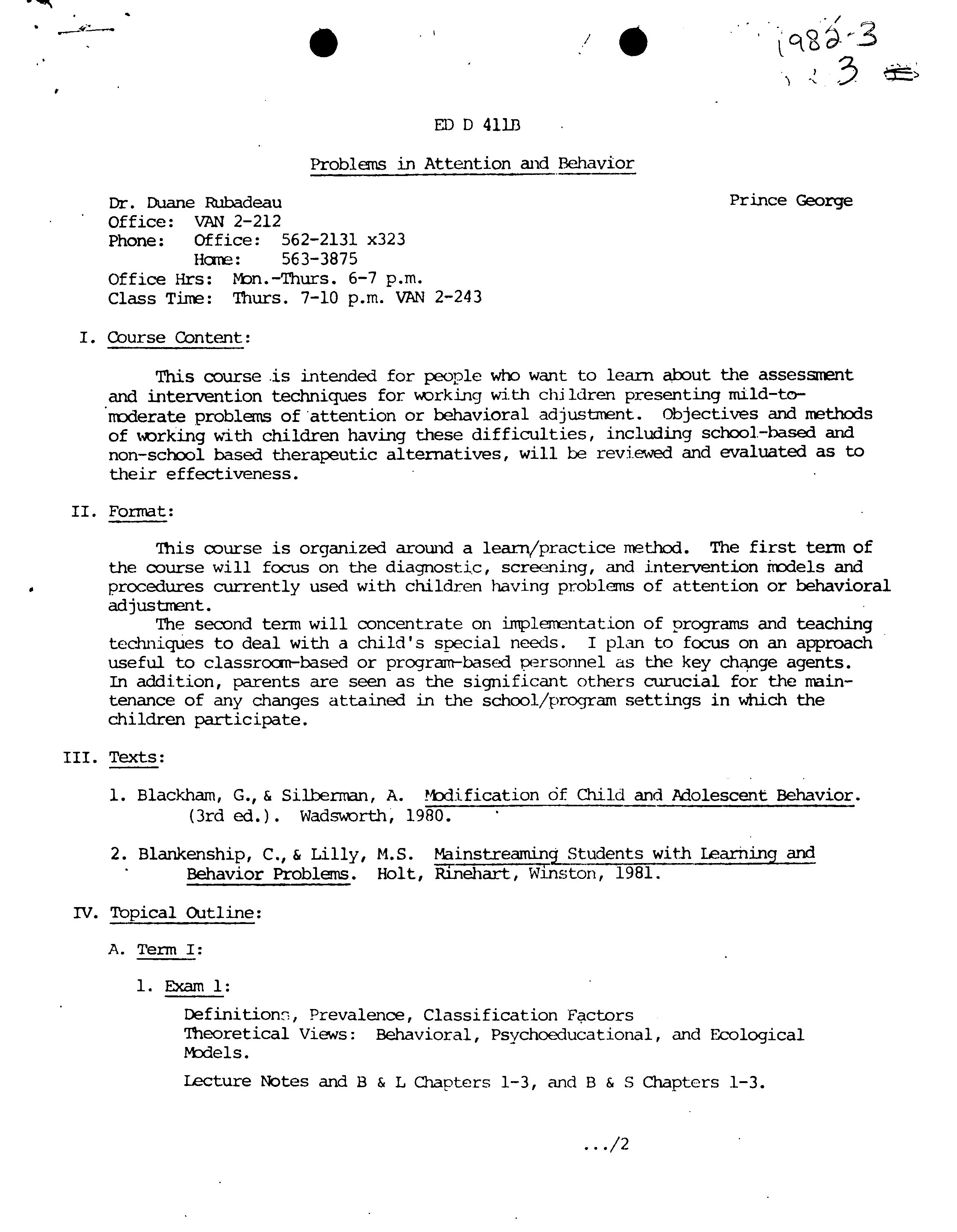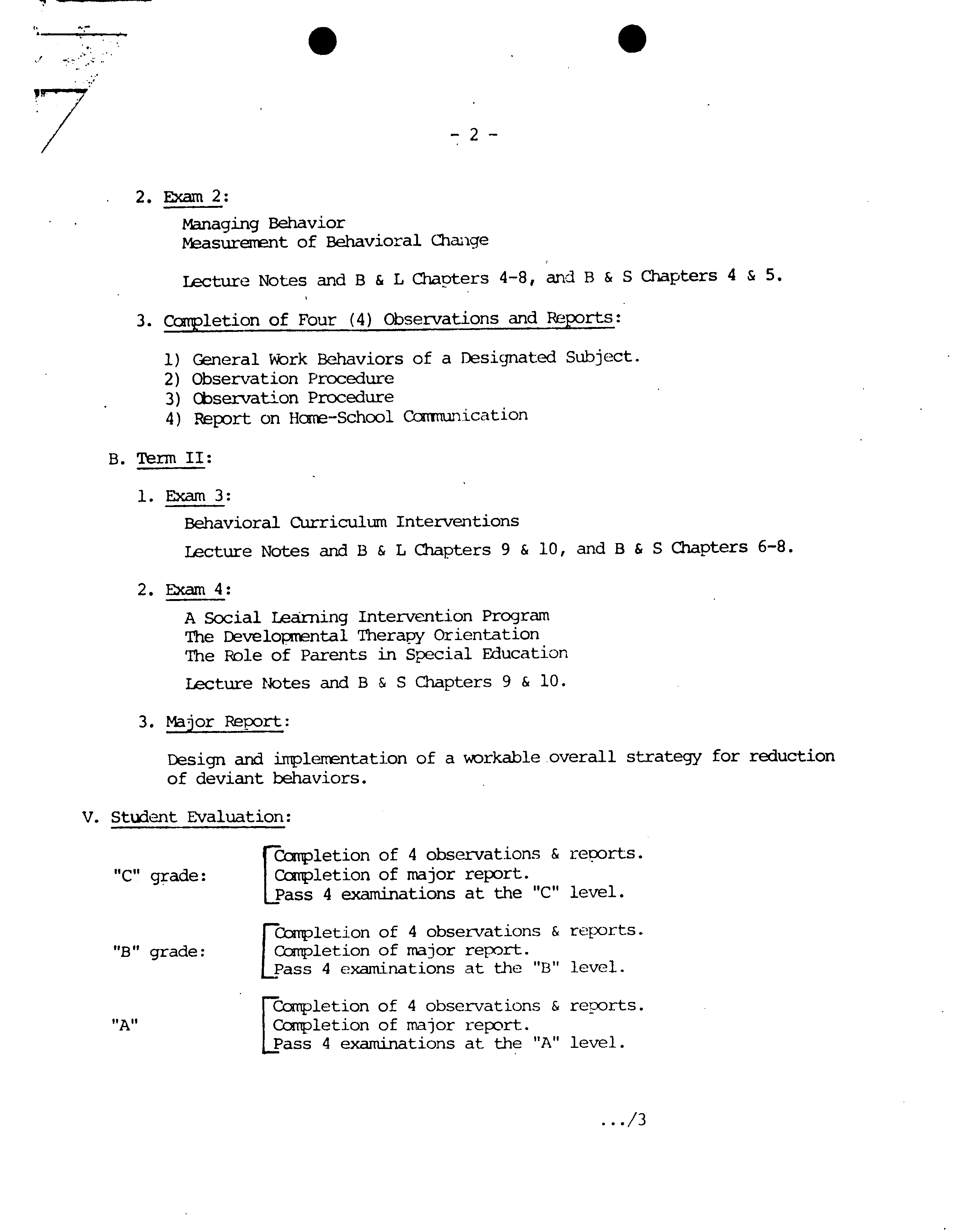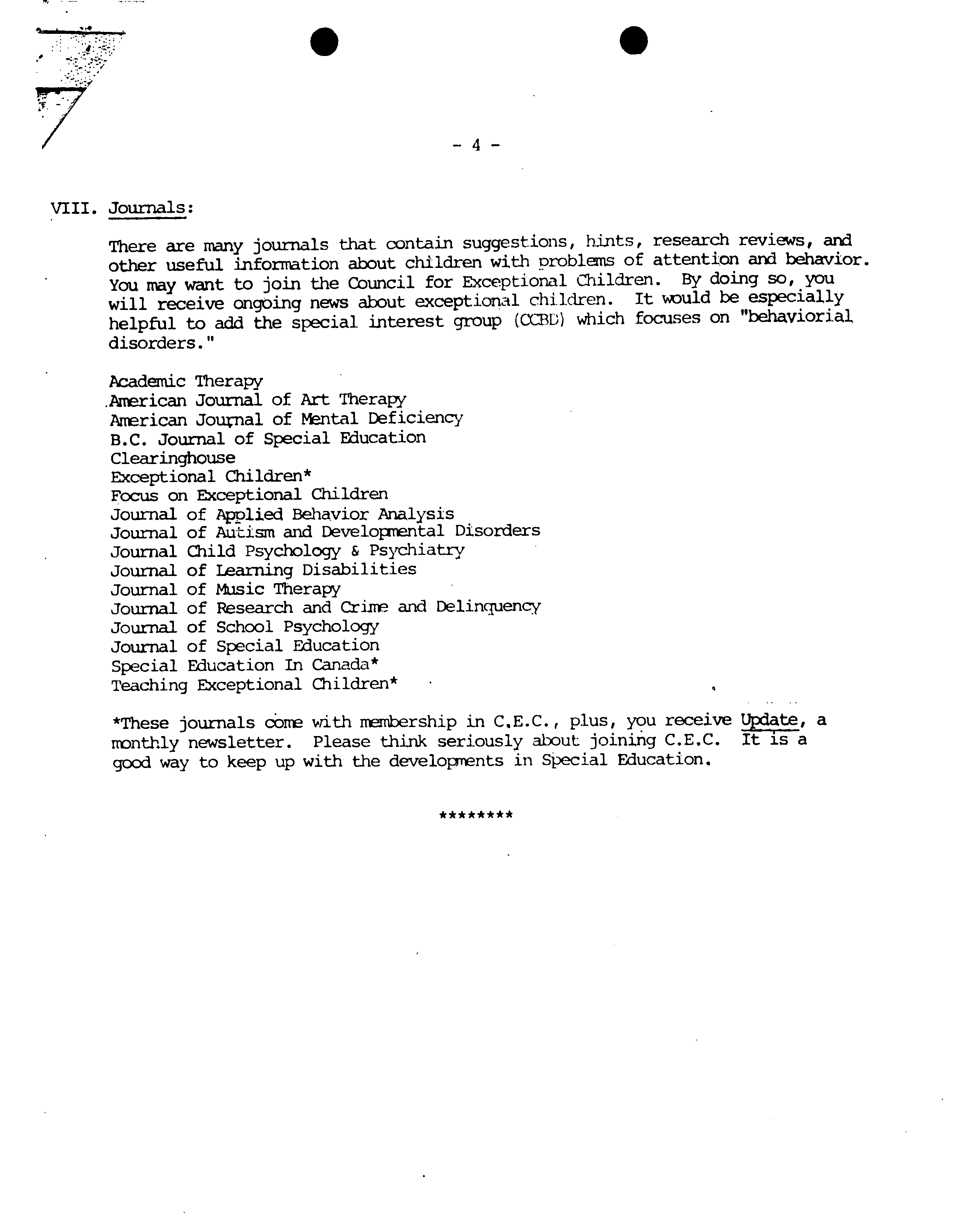•
?
,1
EDD41IJ3
Problems in Attention and Behavior
Dr. Duane Rubadeau
Office: VAN 2-212
Phone: Office: 562-2131 x323
Hair: ?
563-3875
Office Hrs: Mon.-Thurs. 6-7 p.m.
Class Tin: Thurs. 7-10 p.m. VAN 2-243
I. Course Content:
Prince George
This course is intended for people who want to learn about the assessment
and intervention techniques for working with children presenting mild-to-
moderate problems of attention or behavioral adjustment. Objectives and methods
of working with children having these difficulties, including school-based and
non-school based therapeutic alternatives, will be reviewed and evaluated as to
their effectiveness.
II. Format:
This course is organized around a learn/practice method. The first term of
the course will focus on the diagnostic, screening, and intervention trodels and
procedures currently used with children having problems of attention or behavioral
adjustment.
The second term will concentrate on isnplenentation of programs and teaching
techniques to deal with a child's special
needs. I plan to focus on an approach
useful to classroan-based or program-based personnel as the key change agents.
In addition, parents are seen as the significant others curucial for the main-
tenance of any changes attained in the school/program settings in which the
children participate.
III. Texts:
1.
Blackham, G., & Silberman, A. Modification df Child and Adolescent Behavior.
(3rd ed.). Wadsworth, 1980.
2. Blankenship, C.,& Lilly, M.S. Mainstreamin q
udents with Learning and
Behavior Problems. Holt,
?
hart, Winston, 1981.
IV. TopicalOutline:
A. Term
I:
1. Exam 1:
Definitioni, Prevalence, Classification Fctors
Theoretical Views: Behavioral, Psvchoeducational, and Ecological
Models.
Lecture Notes and B & L Chapters 1-3, and B & S Chapters 1-3.
/2
2.
Exam 2:
Managing Behavior
measurement of Behavioral Change
Lecture Notes and
B
& L Cha
p
ters
4-8,
and
B & S Chapters 4 & 5.
3. Completion of Four
(4)
Observations
and
Reports:
1)
General Work Behaviors of a Designated Subject.
2)
Observation Procedure
3)
Observation Procedure
4)
Report on Home-School Carrru.micatiOn
B. Term II:
1.
Exam 3:
Behavioral Curriculum Interventions
Lecture Notes and B & L Chapters 9 & 10, and B & S Chapters 6-8.
2.
Exam 4:
A Social Learning Intervention Program
The Developmental Thera
p
y Orientation
The Pole of Parents in Special Education
Lecture Notes and B & S Chapters 9 & 10.
3.
Major Report:
Design and implementation of a workable overall strategy for reduction
of deviant behaviors.
V. Student Evaluation:
rccietion of 4 observations & reoorts.
"C" grade:
?
JCcmpletion of major report.
LPass 4 examinations at the "C" level.
rca1etion of 4 observations & reports.
"B" grade: ?
J
Canpietion of major report.
LPass
4 examinations at the "13" level.
E
cor
v 1etion
of 4 observations & reoorts.
"A"
?
I
Completion of major report.
L P
ass 4 examinations at the "A" level.
/3
S ?
S
VI. Course Objectives:
From the combination of textbook, lecture and aoolied situations, the student
will be able to:
1.
Collect and organize information from classroom observation, analysis of
work samples, previous test results, student records, etc., in order to
prepare an I.E.P.
2.
Identify appro
p
riate instructional activities for students with behavior
problems and to identify when to modify those activities.
3.
Identify and modify, if necessary, ap
p.
propriate measurement procedures in
order to determine the needs of the student with behavior problems.
4.
State and employ a behavioral decision-making model when working with
students with behavior problems.
5.
State
some
typical ways in which behavior
p
roblem students will act in
specific situations and identify sane strategies to intervene with this
student.
6.
Identify sources of information on behavior problems outside of those
presented in ED D 411B.
VII. Bibliography:
Hannill, D., & Bartel, N. Teaching Children With Learning And Behavior
Problems. Allyn & Bacon, 1978.
Long, N., Morse, W., & Newman, R. COnflict In The Classroom (4th ed.).
Wadsworth, 1980.
Millman, H., Schaefer, C., & Cohen, J. Therapies For Sch
o ol Behavior Problems.
Jossey-Bass, 1980.
Newcr, P. L. Understanding And Teaching Emotionally Disturbed Children.
Allyn & Bacon, 1980.
Ross, A. Psychological Disorders Of Children. McGraw-Hill, 1980.
Smith, J., & Smith, D. Child Mana
gement. Research Press, 1976.
Wallace, G., & Kauffman, J. Teaching Children With
Learning
Problems.
(2nd ed.). Merrill, 1978.
/4
. ? .
-4
-
VIII. Journals:
There are many journals that contain suggestions, hints, research reviews, and
other useful information about children with problems of attention and behavior.
You may want to join the Council for Exceptional Children. By doing so, you
will receive ongoing news about exceptional children. It would be especially
helpful to add the special interest group (CCBD) which focuses on "behavioria],
disorders."
Academic Therapy
.Merican Journal of Art Therapy
Amarican Journal of Mental Deficiency
B.C. Journal of Special Education
Clearinghouse
Exceptional Children*
Focus on Exceptional Children
Journal of Applied Behavior Analysis
Journal of Autism and Developrntal Disorders
Journal Child Psychology & Psychiatry
Journal of Learning Disabilities
Journal of Music Therapy
Journal of Research and Criii and Delinquency
Journal of School Psychology
Journal of Special Education
Special Education In Canada*
Teaching Exceptional Children*
*These journals cone with nbership in C.E.C., plus, you receive Update, a
rtonthly newsletter. Please think seriously about joining C.E.C. It is a
good way to keep up with the developTents in Special Education.
********




